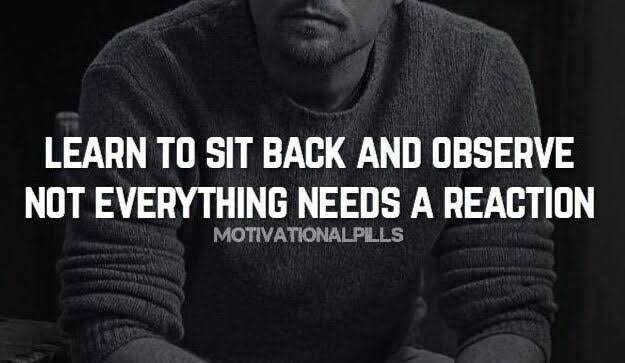In a world that is constantly moving and evolving, it’s easy to feel the pressure to always be active, involved, and responsive. However, there is immense value in learning to sit back and observe. Not everything requires your immediate attention or intervention. This approach can lead to better decision-making, improved relationships, and a deeper understanding of the world around you.
The Art of Observation
Observation is a skill that can be honed with practice. It involves paying attention to the details of a situation, listening more than speaking, and allowing yourself the time to process information before reacting. By observing, you can gather valuable insights that might be missed in the rush to respond.
Benefits of Observing
Enhanced Understanding: Taking the time to observe allows you to see the bigger picture and understand the underlying dynamics of a situation. This can lead to more informed decisions and actions.
Improved Relationships: When you observe, you become more attuned to the needs and emotions of others. This can improve your interpersonal skills and strengthen your relationships.
Stress Reduction: Constantly feeling the need to act or respond can be stressful. By learning to sit back and observe, you can reduce unnecessary stress and maintain a calmer, more balanced mindset.
The Power of Patience
Patience is closely tied to the ability to observe. It requires you to trust that not every situation needs an immediate response and that sometimes, the best action is no action at all. Patience allows you to wait for the right moment to act, rather than reacting impulsively.
Developing Patience
Mindfulness Practices: Engaging in mindfulness practices such as meditation or deep breathing can help you develop patience. These practices encourage you to focus on the present moment and let go of the urge to rush.
Setting Realistic Expectations: Understand that not everything will happen according to your timeline. Setting realistic expectations can help you cultivate patience and reduce frustration.
Learning from Experience: Reflect on past experiences where patience has paid off. Use these reflections to remind yourself of the benefits of waiting and observing.
Knowing When to Act
While observation and patience are crucial, it’s also important to recognize when it’s time to act. The key is finding a balance between observing and responding. Here are some tips to help you determine the right moment to act:
Gather Sufficient Information: Before making a decision, ensure you have enough information to make an informed choice. This often requires taking the time to observe and analyze the situation.
Trust Your Intuition: Sometimes, your intuition can guide you in knowing when to act. Trust your gut feelings, especially if they are supported by your observations.
Evaluate the Impact: Consider the potential impact of your actions. If immediate action is necessary to prevent harm or seize an opportunity, then it’s time to act.
Learning to sit back and observe is a valuable skill in today’s fast-paced world. By cultivating patience and knowing when to act, you can navigate life’s challenges more effectively and enjoy deeper, more meaningful interactions with those around you. Remember, not everything needs your immediate attention. Sometimes, the best course of action is to simply observe and let things unfold naturally.
The Wisdom of Stillness
In a culture that often glorifies busyness and constant activity, the wisdom of stillness can be easily overlooked. However, embracing stillness doesn’t mean being inactive; it means finding a calm center from which to observe and understand the world around you.
Embracing Stillness
Mindful Awareness: Practicing mindfulness allows you to focus on the present moment without judgment. This heightened awareness helps you notice the subtleties of your environment and your internal state.
Reflective Practices: Journaling, meditation, and quiet contemplation can help you connect with your inner thoughts and feelings. These practices foster a deeper understanding of yourself and your surroundings.
Nature Connection: Spending time in nature encourages stillness and observation. The natural world moves at its own pace, providing a perfect backdrop for practicing the art of stillness.
Listening More, Speaking Less
One of the most powerful aspects of observation is listening. By listening more and speaking less, you open yourself up to understanding others on a deeper level. This not only improves your communication skills but also builds stronger relationships.
Effective Listening
Active Listening: Engage fully with the speaker, showing interest through body language and eye contact. Avoid interrupting and allow them to express their thoughts completely.
Empathetic Listening: Try to understand the speaker’s perspective and feelings. Empathetic listening fosters trust and connection.
Reflective Responses: Instead of immediately offering advice or opinions, reflect back what you’ve heard. This demonstrates that you value the speaker’s input and are truly listening.
The Role of Observation in Leadership
Great leaders often excel at observation. They understand that by stepping back and observing, they can gain valuable insights into their team’s dynamics, identify potential issues early, and make more strategic decisions.
Leadership Through Observation
Understanding Team Dynamics: Observing interactions within your team can help you understand individual strengths and weaknesses, as well as group dynamics. This knowledge is crucial for effective team management.
Identifying Issues Early: By being observant, you can spot potential problems before they escalate. This proactive approach allows you to address issues promptly and prevent larger conflicts.
Informed Decision-Making: Leaders who observe and gather information before making decisions are often more effective. They base their actions on a comprehensive understanding of the situation rather than impulsive reactions.
Cultivating a Culture of Observation
Creating an environment where observation is valued can lead to a more thoughtful, reflective, and effective organization. Encourage your team to take time for observation and reflection, and model this behavior yourself.
Strategies for Cultivation
Encourage Breaks: Promote regular breaks throughout the workday for quiet reflection and observation. These breaks can boost creativity and productivity.
Lead by Example: Demonstrate the value of observation by practicing it yourself. Show your team that taking time to observe leads to better outcomes.
Provide Tools and Training: Offer resources and training on mindfulness, active listening, and reflective practices. Equip your team with the skills they need to observe effectively.
The Balance Between Observation and Action
Finding the right balance between observation and action is key to success. While it’s important to take the time to observe, it’s equally important to know when to move from observation to action.
Achieving Balance
Set Clear Goals: Define what you want to achieve with your observation. Having clear goals helps you know when you have gathered enough information to take action.
Create Action Plans: After observing, create a structured plan for action. This ensures that your observations lead to meaningful outcomes.
Review and Adjust: Regularly review the results of your actions and adjust your approach based on new observations. This continuous cycle of observation and action leads to ongoing improvement.
Conclusion
Learning to sit back and observe is not about inaction; it’s about thoughtful engagement with the world. By embracing stillness, listening more, and balancing observation with action, you can make better decisions, build stronger relationships, and lead more effectively. Remember, not everything requires immediate attention. Sometimes, the greatest wisdom comes from simply sitting back and observing the world unfold.


